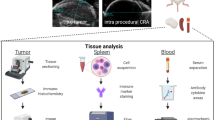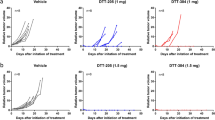Abstract
Following excision of colorectal tumors, metastatic disease is prevalent, primarily occurs in the liver, and is highly predictive of poor prognosis. The perioperative period is now recognized as critical in determining the incidence of postoperative metastases and long-term cancer outcomes. Thus, various perioperative prophylactic interventions are currently studied during this time frame. However, immune stimulation during the perioperative period has rarely been attempted due to specific contraindications to surgery and various adverse effects. Here, to prevent liver metastases, we perioperatively employed a TLR-9 agonist, CpG-C, which exhibits minimal pyrogenic and other adverse effects in patients. We found that marginating-hepatic (MH) cells in BALB/c mice contained high percentage of NK cells, but exhibited negligible NK cytotoxicity, as previously reported in humans. However, a single CpG-C administration (25-100 µg/mouse) doubled MH-NK cell numbers, increased NK cell activation and maturation markers (NKp46, CD11b), decreased the inhibitory NKG2A ligand, and dramatically increased MH-NK-cell cytotoxicity against the syngeneic CT26 colon cancer line. Moreover, in operated mice, this innocuous intervention also markedly improved resistance to CT26 and MC38 hepatic metastases in BALB/c and C57BL/6 mice, respectively. Beneficial effects of CpG-C were mediated through activation of MH-NK cells, as indicated by an in vivo NK depletion study. Last, CpG-C protected against surgery-induced suppression of MH-NK cytotoxicity and improved their activation indices. Thus, we suggest that systemic perioperative CpG-C treatment should be considered and studied as a novel therapeutic approach to improve long-term cancer outcomes in colorectal cancer patients.






Similar content being viewed by others
Abbreviations
- CCR7:
-
Chemokine receptor 7
- CpG-C ODN:
-
Oligodeoxynucleotides (ODN) containing unmethylated CpG dinucleotides (CpG ODN)
- CRC:
-
Colorectal cancer/carcinoma
- CT26:
-
Colon tumor cell line
- IFN:
-
Interferon
- MC38:
-
Mouse colon cell line
- MH-NK cell:
-
Marginating-hepatic NK cell
- MP-NK cell:
-
Marginating pulmonary NK cell
- MRD:
-
Minimal residual disease
- NKCC:
-
NK cells cytotoxicity
- pDC:
-
plasmacytoid dendritic cells
- TLR9:
-
Toll-like receptor 9
- TRAIL:
-
TNF-related apoptosis-inducing ligand
References
Ferlay J et al (2019) Global cancer observatory: cancer today. 2018 [cited 2019 2/11/2019]; Available from: https://gco.iarc.fr/today
Morris EJ et al (2010) Surgical management and outcomes of colorectal cancer liver metastases. Br J Surg 97(7):1110–1118
Neeman E, Zmora O, Ben-Eliyahu S (2012) A new approach to reducing postsurgical cancer recurrence: perioperative targeting of catecholamines and prostaglandins. Clin Cancer Res 18(18):4895–4902
Horowitz M et al (2015) Exploiting the critical perioperative period to improve long-term cancer outcomes. Nat Rev Clin Oncol 12(4):213–226
Yamaguchi K et al (2000) Significant detection of circulating cancer cells in the blood by reverse transcriptase-polymerase chain reaction during colorectal cancer resection. Ann Surg 232(1):58–65
Ben-Eliyahu S (2003) The promotion of tumor metastasis by surgery and stress: immunological basis and implications for psychoneuroimmunology. Brain Behav Immun 17(Suppl 1):S27–S36
Fisher B et al (1989) Presence of a growth-stimulating factor in serum following primary tumor removal in mice. Cancer Res 49(8):1996–2001
Shaashua L et al (2017) Perioperative COX-2 and beta-adrenergic blockade improves metastatic biomarkers in breast cancer patients in a phase-II randomized trial. Clin Cancer Res 23(16):4651–4661
Melamed R et al (2005) Marginating pulmonary-NK activity and resistance to experimental tumor metastasis: suppression by surgery and the prophylactic use of a beta-adrenergic antagonist and a prostaglandin synthesis inhibitor. Brain Behav Immun 19(2):114–126
Wisse E et al (1976) The pit cell: description of a new type of cell occurring in rat liver sinusoids and peripheral blood. Cell Tissue Res 173(4):423–435
Kaneda K, Wake K (1983) Distribution and morphological characteristics of the pit cells in the liver of the rat. Cell Tissue Res 233(3):485–505
Sun H et al (2013) NK cells in immunotolerant organs. Cell Mol Immunol 10(3):202–212
Carson WE et al (1999) A fatal cytokine-induced systemic inflammatory response reveals a critical role for NK cells. J Immunol 162(8):4943–4951
Krieg AM (2002) CpG motifs in bacterial DNA and their immune effects. Annu Rev Immunol 20:709–760
Sivori S et al (2006) Comparison of different CpG oligodeoxynucleotide classes for their capability to stimulate human NK cells. Eur J Immunol 36(4):961–967
Poeck H et al (2004) Plasmacytoid dendritic cells, antigen, and CpG-C license human B cells for plasma cell differentiation and immunoglobulin production in the absence of T-cell help. Blood 103(8):3058–3064
Kwong B, Liu H, Irvine DJ (2011) Induction of potent anti-tumor responses while eliminating systemic side effects via liposome-anchored combinatorial immunotherapy. Biomaterials 32(22):5134–5147
Guiducci C et al (2006) Properties regulating the nature of the plasmacytoid dendritic cell response to Toll-like receptor 9 activation. J Exp Med 203(8):1999–2008
Liu M et al (2019) Metabolic rewiring of macrophages by CpG potentiates clearance of cancer cells and overcomes tumor-expressed CD47-mediated ‘don’t-eat-me’ signal. Nat Immunol 20(3):265–275
Corbett TH et al (1975) Tumor induction relationships in development of transplantable cancers of the colon in mice for chemotherapy assays, with a note on carcinogen structure. Cancer Res 35(9):2434–2439
Sorski L et al (2014) The impact of surgical extent and sex on the hepatic metastasis of colon cancer. Surg Today 44(10):1925–1934
Sorski L et al. (2016) Selective harvesting of marginating-hepatic leukocytes. J Vis Exp, 113
Melamed R et al (2010) The marginating-pulmonary immune compartment in rats: characteristics of continuous inflammation and activated NK cells. J Immunother 33(1):16–29
Vollmar B, Menger MD (2009) The hepatic microcirculation: mechanistic contributions and therapeutic targets in liver injury and repair. Physiol Rev 89(4):1269–1339
Zhang J et al (2005) Isolation of lymphocytes and their innate immune characterizations from liver, intestine, lung and uterus. Cell Mol Immunol 2(4):271–280
Agorku DJ et al (2019) CD49b, CD87, and CD95 are markers for activated cancer-associated fibroblasts whereas CD39 marks quiescent normal fibroblasts in murine tumor models. Front Oncol 9:716
Hemmi H et al (2000) A Toll-like receptor recognizes bacterial DNA. Nature 408(6813):740–745
Takeshita F et al (2001) Cutting edge: role of Toll-like receptor 9 in CpG DNA-induced activation of human cells. J Immunol 167(7):3555–3558
Ashkar AA, Rosenthal KL (2002) Toll-like receptor 9, CpG DNA and innate immunity. Curr Mol Med 2(6):545–556
Krieg AM et al (1995) CpG motifs in bacterial DNA trigger direct B-cell activation. Nature 374(6522):546–549
Krug A et al (2001) Identification of CpG oligonucleotide sequences with high induction of IFN-alpha/beta in plasmacytoid dendritic cells. Eur J Immunol 31(7):2154–2163
Della Chiesa M et al (2006) Multidirectional interactions are bridging human NK cells with plasmacytoid and monocyte-derived dendritic cells during innate immune responses. Blood 108(12):3851–3858
Mathan TS, Figdor CG, Buschow SI (2013) Human plasmacytoid dendritic cells: from molecules to intercellular communication network. Front Immunol 4:372
Adams DH, Eksteen B, Curbishley SM (2008) Immunology of the gut and liver: a love/hate relationship. Gut 57(6):838–848
Crispe IN (2003) Hepatic T cells and liver tolerance. Nat Rev Immunol 3(1):51–62
Lassen MG et al (2010) Intrahepatic IL-10 maintains NKG2A + Ly49- liver NK cells in a functionally hyporesponsive state. J Immunol 184(5):2693–2701
Crispe IN (2014) Immune tolerance in liver disease. Hepatology 60(6):2109–2117
Jinushi M et al (2007) Natural killer cell and hepatic cell interaction via NKG2A leads to dendritic cell-mediated induction of CD4 CD25 T cells with PD-1-dependent regulatory activities. Immunology 120(1):73–82
Nishikado H et al (2011) NK cell-depleting anti-asialo GM1 antibody exhibits a lethal off-target effect on basophils in vivo. J Immunol 186(10):5766–5771
Victorino F et al (2015) Tissue-resident NK cells mediate ischemic kidney injury and are not depleted by anti-asialo-GM1 antibody. J Immunol 195(10):4973–4985
Benish M et al (2008) Perioperative use of beta-blockers and COX-2 inhibitors may improve immune competence and reduce the risk of tumor metastasis. Ann Surg Oncol 15(7):2042–2052
Glasner A et al (2010) Improving survival rates in two models of spontaneous postoperative metastasis in mice by combined administration of a beta-adrenergic antagonist and a cyclooxygenase-2 inhibitor. J Immunol 184(5):2449–2457
Clinthorne JF et al (2013) NK cell maturation and function in C57BL/6 mice are altered by caloric restriction. J Immunol 190(2):712–722
Goldfarb Y et al (2009) CpG-C oligodeoxynucleotides limit the deleterious effects of beta-adrenoceptor stimulation on NK cytotoxicity and metastatic dissemination. J Immunother 32(3):280–291
Jahrsdorfer B, Weiner GJ (2008) CpG oligodeoxynucleotides as immunotherapy in cancer. Update Cancer Ther 3(1):27–32
Funding
This work was supported by NIH/NCI Grant # CA125456 and CA172138 (SBE) and by the Israel-USA bi-national Science Foundation # 2005331 (SBE & GGP).
Author information
Authors and Affiliations
Contributions
LS is the lead researcher of the studies presented in this paper, and is reponsible for designing, initiating and performing all the experiments presented herein, analyzing their data, and writing the paper itslef. RM assisted performing both the in vivo and ex vivo experiments and helped analysing their data. BL assisted performing the in vivo experiments. PM assisted performing the in vivo experimnts, and analyzing the ex vivo expreiments data. HL assisted performing the in vivo experiments. ER assisted in cells lines preperation and handling, and in analyzing the data. LS assisted performing the in vivo experiments. IR assisted in analyzing the data. ES assisted in performing the in vivo experiments. AB assisted in analyzing the data. SB-E is the principal investigator of the lab and is involved in the design of the experiments, in performing and analyzing their data, and in advising and assisting in writing the paper.
Corresponding author
Ethics declarations
Conflict of interest
The authors declare that they have no conflict of interest.
Ethical approval and ethical standards
The Institutional Animal Care and Use Committee of Tel Aviv University approved all studies.
Approval numbers for the experiments
CT26 – P-13-014, MC38 – 10-18-007.
Animal source
BALB/c male and female mice and C57B1/6j male and female mice were purchased from Harlan laboratories (Jerusalem, Israel) at the age of 4 weeks. Animals were housed 3–4 per cage at 22 ± 1 °C, on a 12:12 light/dark cycle and were allowed ad libitum access to food and water. Animals were used at the age of 8–12 weeks. (Animals were age-matched between groups within each experiment.)
Cell line authentication
The CT26 tumor cell line: CT26 tumor cells were kindly provided by Prof. Eliezer Flesher (Department of Human Microbiology, Faculty of Medicine, Tel Aviv University).
The MC38 tumor cell line
The MC38 murine colon adenocarcinoma was derived from tumor that arose in C57B1/6 mice. Tumor cells were kindly provided by Dr. Eran Nizri (Tel Aviv Sourasky Medical center).
Additional information
Publisher's Note
Springer Nature remains neutral with regard to jurisdictional claims in published maps and institutional affiliations.
Rights and permissions
About this article
Cite this article
Sorski, L., Melamed, R., Levi, B. et al. Prevention of liver metastases through perioperative acute CpG-C immune stimulation. Cancer Immunol Immunother 69, 2021–2031 (2020). https://doi.org/10.1007/s00262-020-02596-7
Received:
Accepted:
Published:
Issue Date:
DOI: https://doi.org/10.1007/s00262-020-02596-7




